Abstract
OBJECTIVES: This article proposes a new stress-coping model for American Indians and Alaska Natives (AIs) that reflects a paradigmatic shift in the conceptualization of Native health. It reviews sociodemographic information on AIs, rates of substance abuse and related health outcomes, and the research supporting the model's pathways. OBSERVATIONS: Although health outcomes among AIs are improving, large disparities with other racial and ethnic groups in the United States remain. Many health-related problems are directly linked to high rates of substance use and abuse. CONCLUSION: Eurocentric paradigms focus on individual pathology. An "indigenist" perspective of health incorporates the devastating impact of historical trauma and ongoing oppression of AIs. The model emphasizes cultural strengths, such as the family and community, spirituality and traditional healing practices, and group identity attitudes.
Full text
PDF

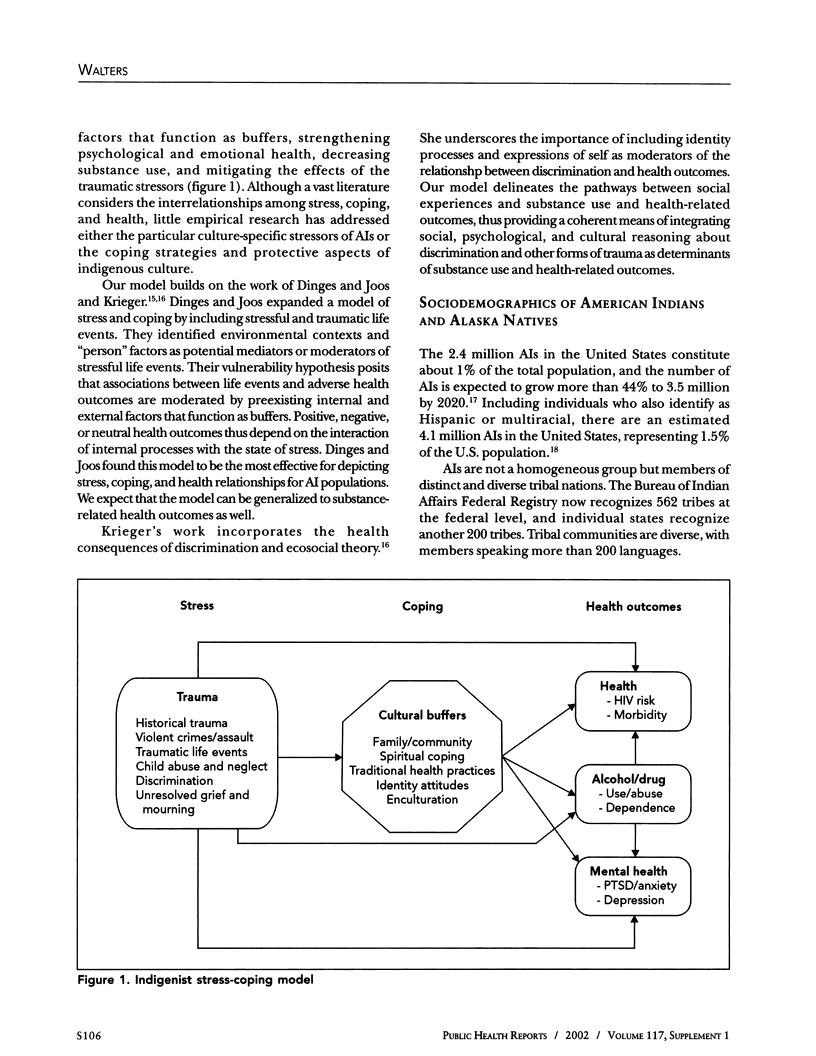
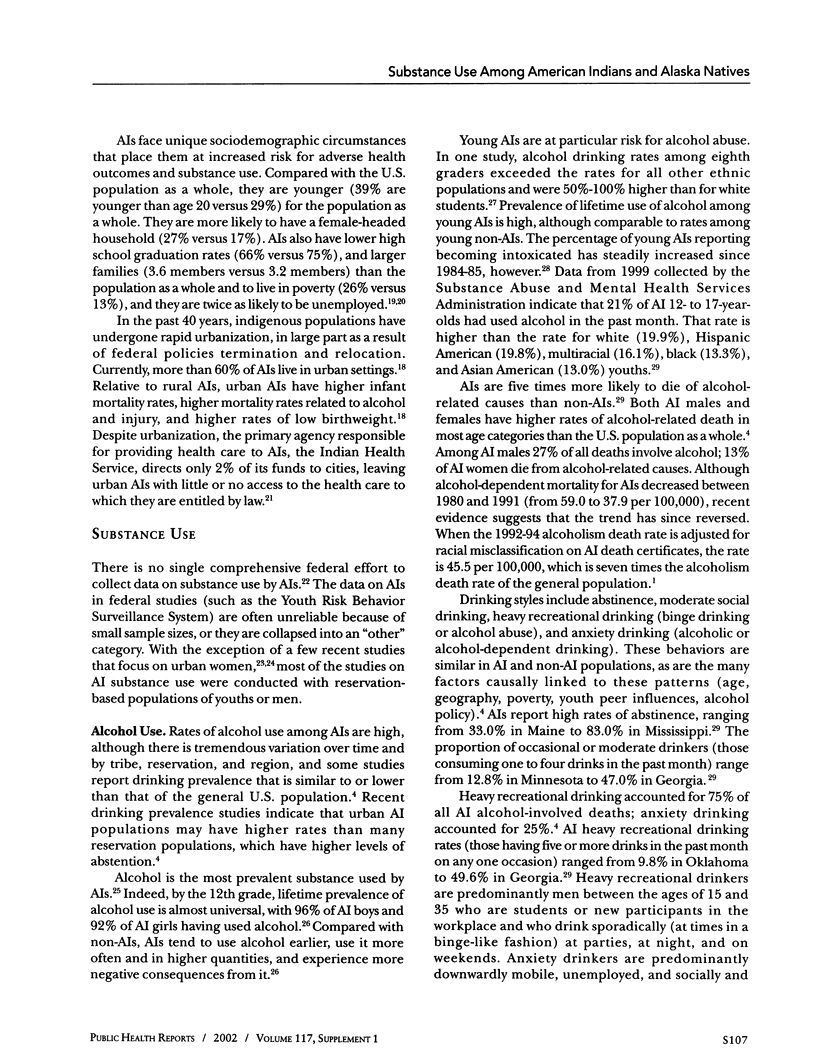
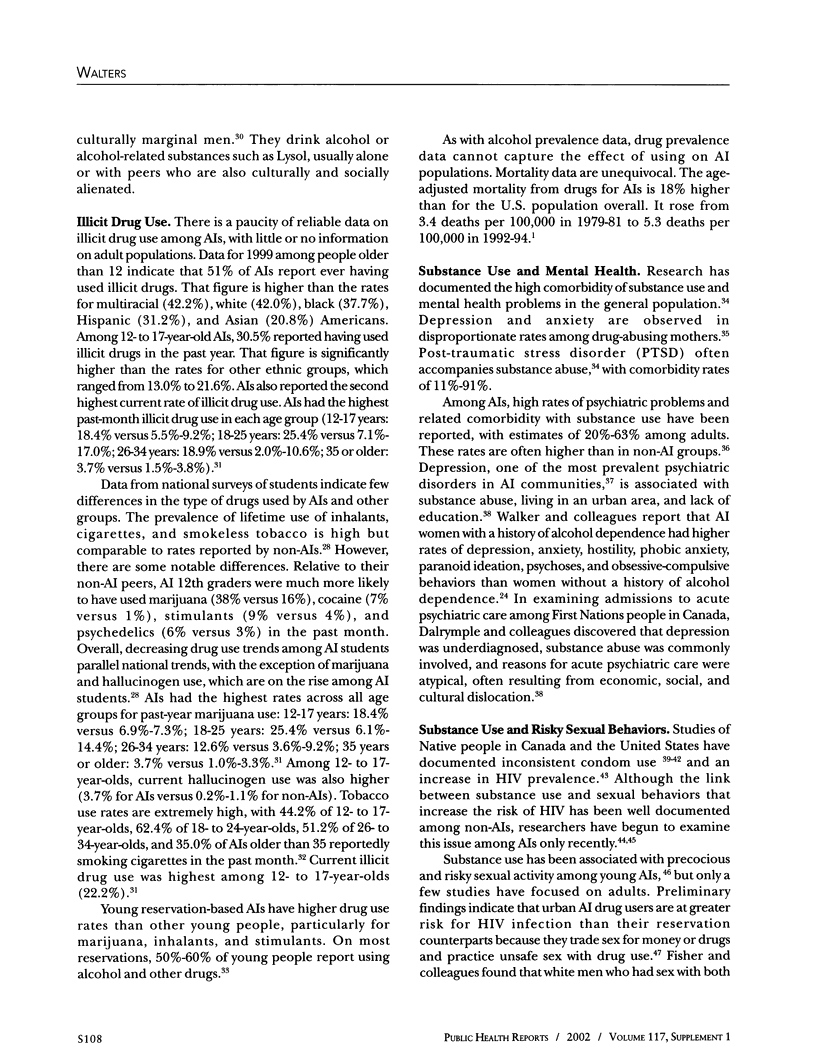


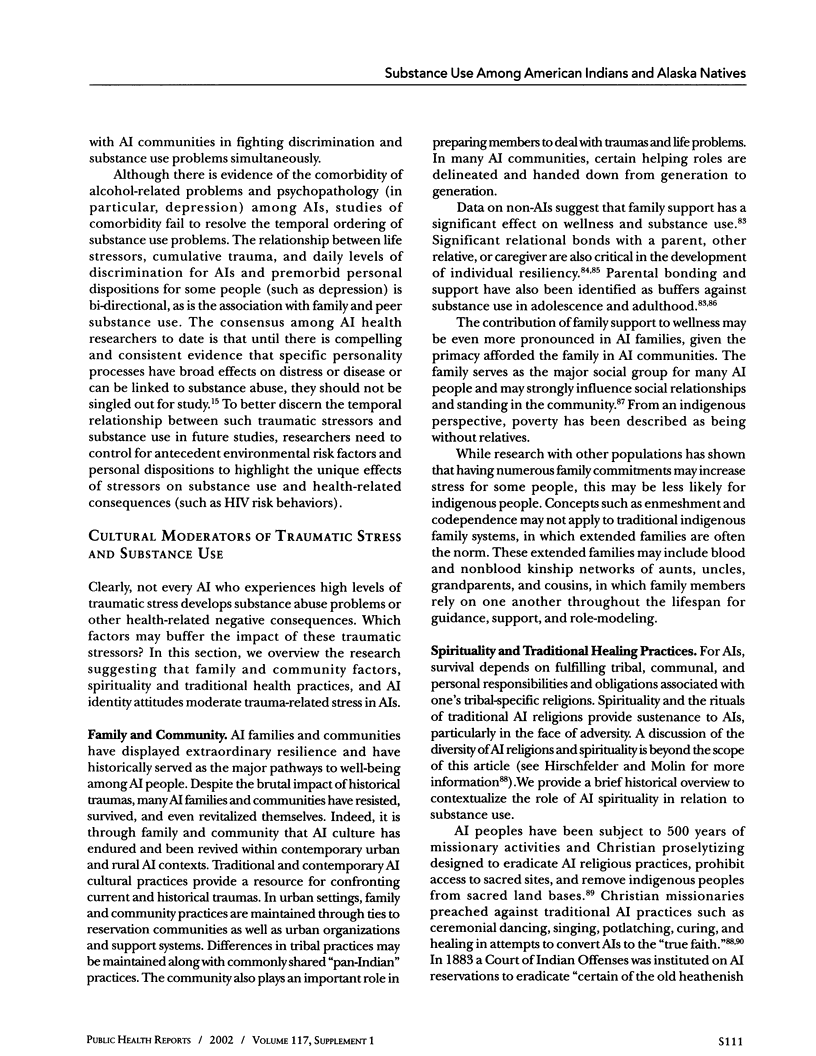



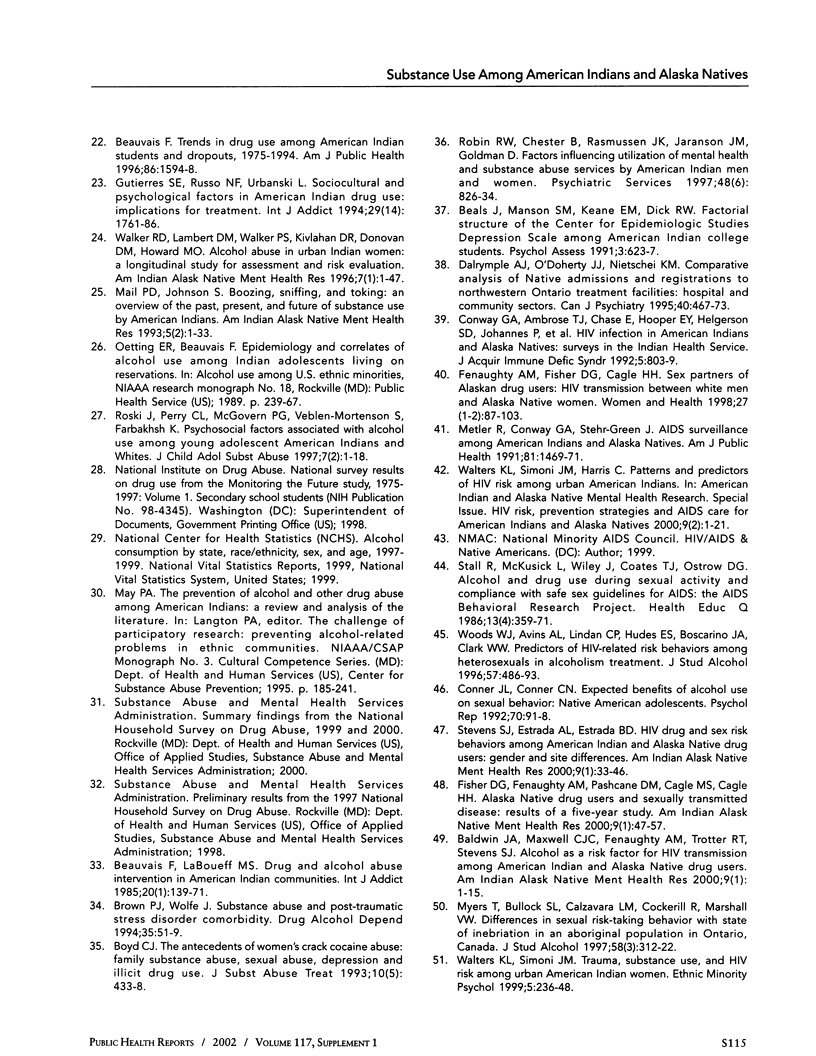


Selected References
These references are in PubMed. This may not be the complete list of references from this article.
- Baldwin J. A., Maxwell C. J., Fenaughty A. M., Trotter R. T., Stevens S. J. Alcohol as a risk factor for HIV transmission among American Indian and Alaska Native drug users. Am Indian Alsk Native Ment Health Res. 2000;9(1):1–16. doi: 10.5820/aian.0901.2000.1. [DOI] [PubMed] [Google Scholar]
- Barnes A., Ephross P. H. The impact of hate violence on victims: emotional and behavioral responses to attacks. Soc Work. 1994 May;39(3):247–251. [PubMed] [Google Scholar]
- Beauvais P. Trends in drug use among American Indian students and dropouts, 1975 to 1994. Am J Public Health. 1996 Nov;86(11):1594–1598. doi: 10.2105/ajph.86.11.1594. [DOI] [PMC free article] [PubMed] [Google Scholar]
- Boyd C. J. The antecedents of women's crack cocaine abuse: family substance abuse, sexual abuse, depression and illicit drug use. J Subst Abuse Treat. 1993 Sep-Oct;10(5):433–438. doi: 10.1016/0740-5472(93)90002-j. [DOI] [PubMed] [Google Scholar]
- Brassard P., Smeja C., Valverde C. Needs assessment for an urban native HIV and AIDS prevention program. AIDS Educ Prev. 1996 Aug;8(4):343–351. [PubMed] [Google Scholar]
- Brave Heart M. Y. Gender differences in the historical trauma response among the Lakota. J Health Soc Policy. 1999;10(4):1–21. doi: 10.1300/J045v10n04_01. [DOI] [PubMed] [Google Scholar]
- Brook J. S., Balka E. B., Brook D. W., Win P. T., Gursen M. D. Drug use among African Americans: ethnic identity as a protective factor. Psychol Rep. 1998 Dec;83(3 Pt 2):1427–1446. doi: 10.2466/pr0.1998.83.3f.1427. [DOI] [PubMed] [Google Scholar]
- Burhansstipanov L. Urban native American health issues. Cancer. 2000 Mar 1;88(5 Suppl):1207–1213. doi: 10.1002/(sici)1097-0142(20000301)88:5+<1207::aid-cncr5>3.3.co;2-k. [DOI] [PubMed] [Google Scholar]
- Conner J. L., Conner C. N. Expected benefits of alcohol use on sexual behavior: Native American adolescents. Psychol Rep. 1992 Feb;70(1):91–98. doi: 10.2466/pr0.1992.70.1.91. [DOI] [PubMed] [Google Scholar]
- Conway G. A., Ambrose T. J., Chase E., Hooper E. Y., Helgerson S. D., Johannes P., Epstein M. R., McRae B. A., Munn V. P., Keevama L. HIV infection in American Indians and Alaska Natives: surveys in the Indian Health Service. J Acquir Immune Defic Syndr. 1992;5(8):803–809. [PubMed] [Google Scholar]
- Cuadrado M., Lieberman L. Traditionalism in the prevention of substance misuse among Puerto Ricans. Subst Use Misuse. 1998 Dec;33(14):2737–2755. doi: 10.3109/10826089809059348. [DOI] [PubMed] [Google Scholar]
- Dalrymple A. J., O'Doherty J. J., Nietschei K. M. Comparative analysis of Native admissions and registrations to northwestern Ontario treatment facilities: hospital and community sectors. Can J Psychiatry. 1995 Oct;40(8):467–473. doi: 10.1177/070674379504000807. [DOI] [PubMed] [Google Scholar]
- Dinges N. G., Joos S. K. Stress, coping, and health: models of interaction for Indian and native populations. Am Indian Alsk Native Ment Health Res Monogr Ser. 1988;1:8–64. doi: 10.5820/aian.mono01.1988.8. [DOI] [PubMed] [Google Scholar]
- Finch B. K., Boardman J. D., Kolody B., Vega W. A. Contextual effects of acculturation on perinatal substance exposure among immigrant and native-born Latinas. Soc Sci Q. 2000;81(1):421–438. [PubMed] [Google Scholar]
- Fisher D. G., Fenaughty A. M., Paschane D. M., Cagle H. H. Alaska Native drug users and sexually transmitted disease: results of a five-year study. Am Indian Alsk Native Ment Health Res. 2000;9(1):47–57. doi: 10.5820/aian.0901.2000.47. [DOI] [PubMed] [Google Scholar]
- Galaif E. R., Stein J. A., Newcomb M. D., Bernstein D. P. Gender differences in the prediction of problem alcohol use in adulthood: exploring the influence of family factors and childhood maltreatment. J Stud Alcohol. 2001 Jul;62(4):486–493. doi: 10.15288/jsa.2001.62.486. [DOI] [PubMed] [Google Scholar]
- Gurley D., Novins D. K., Jones M. C., Beals J., Shore J. H., Manson S. M. Comparative use of biomedical services and traditional healing options by American Indian veterans. Psychiatr Serv. 2001 Jan;52(1):68–74. doi: 10.1176/appi.ps.52.1.68. [DOI] [PubMed] [Google Scholar]
- Gutierres S. E., Russo N. F., Urbanski L. Sociocultural and psychological factors in American Indian drug use: implications for treatment. Int J Addict. 1994 Dec;29(14):1761–1786. doi: 10.3109/10826089409128256. [DOI] [PubMed] [Google Scholar]
- Johnson D. Stress, depression, substance abuse, and racism. Am Indian Alsk Native Ment Health Res. 1994;6(1):29–33. doi: 10.5820/aian.0601.1994.29. [DOI] [PubMed] [Google Scholar]
- Johnson K., Bryant D. D., Collins D. A., Noe T. D., Strader T. N., Berbaum M. Preventing and reducing alcohol and other drug use among high-risk youths by increasing family resilience. Soc Work. 1998 Jul;43(4):297–308. doi: 10.1093/sw/43.4.297. [DOI] [PubMed] [Google Scholar]
- Krieger N. Embodying inequality: a review of concepts, measures, and methods for studying health consequences of discrimination. Int J Health Serv. 1999;29(2):295–352. doi: 10.2190/M11W-VWXE-KQM9-G97Q. [DOI] [PubMed] [Google Scholar]
- Krieger N., Sidney S. Racial discrimination and blood pressure: the CARDIA Study of young black and white adults. Am J Public Health. 1996 Oct;86(10):1370–1378. doi: 10.2105/ajph.86.10.1370. [DOI] [PMC free article] [PubMed] [Google Scholar]
- Mail P. D., Johnson S. Boozing, sniffing, and toking: an overview of the past, present, and future of substance use by American Indians. Am Indian Alsk Native Ment Health Res. 1993;5(2):1–33. doi: 10.5820/aian.0502.1993.1. [DOI] [PubMed] [Google Scholar]
- Marbella A. M., Harris M. C., Diehr S., Ignace G., Ignace G. Use of Native American healers among Native American patients in an urban Native American health center. Arch Fam Med. 1998 Mar-Apr;7(2):182–185. doi: 10.1001/archfami.7.2.182. [DOI] [PubMed] [Google Scholar]
- Metler R., Conway G. A., Stehr-Green J. AIDS surveillance among American Indians and Alaska natives. Am J Public Health. 1991 Nov;81(11):1469–1471. doi: 10.2105/ajph.81.11.1469. [DOI] [PMC free article] [PubMed] [Google Scholar]
- Myers T., Bullock S. L., Calzavara L. M., Cockerill R., Marshall V. W. Differences in sexual risk-taking behavior with state of inebriation in an aboriginal population in Ontario, Canada. J Stud Alcohol. 1997 May;58(3):312–322. doi: 10.15288/jsa.1997.58.312. [DOI] [PubMed] [Google Scholar]
- O'Nell T. D., Mitchell C. M. Alcohol use among American Indian adolescents: the role of culture in pathological drinking. Soc Sci Med. 1996 Feb;42(4):565–578. doi: 10.1016/0277-9536(95)00157-3. [DOI] [PubMed] [Google Scholar]
- Oetting E. R., Beauvais F. Orthogonal cultural identification theory: the cultural identification of minority adolescents. Int J Addict. 1990;25(5A-6A):655–685. doi: 10.3109/10826089109077265. [DOI] [PubMed] [Google Scholar]
- Phinney J. S. Ethnic identity in adolescents and adults: review of research. Psychol Bull. 1990 Nov;108(3):499–514. doi: 10.1037/0033-2909.108.3.499. [DOI] [PubMed] [Google Scholar]
- Ren X. S., Amick B. C., Williams D. R. Racial/ethnic disparities in health: the interplay between discrimination and socioeconomic status. Ethn Dis. 1999 Spring-Summer;9(2):151–165. [PubMed] [Google Scholar]
- Robin R. W., Chester B., Rasmussen J. K., Jaranson J. M., Goldman D. Factors influencing utilization of mental health and substance abuse services by American Indian men and women. Psychiatr Serv. 1997 Jun;48(6):826–832. doi: 10.1176/ps.48.6.826. [DOI] [PubMed] [Google Scholar]
- Stall R., McKusick L., Wiley J., Coates T. J., Ostrow D. G. Alcohol and drug use during sexual activity and compliance with safe sex guidelines for AIDS: the AIDS Behavioral Research Project. Health Educ Q. 1986 Winter;13(4):359–371. doi: 10.1177/109019818601300407. [DOI] [PubMed] [Google Scholar]
- Stevens S. J., Estrada A. L., Estrada B. D. HIV drug and sex risk behaviors among American Indian and Alaska Native drug users: gender and site differences. Am Indian Alsk Native Ment Health Res. 2000;9(1):33–46. doi: 10.5820/aian.0901.2000.33. [DOI] [PubMed] [Google Scholar]
- Stewart S. H. Alcohol abuse in individuals exposed to trauma: a critical review. Psychol Bull. 1996 Jul;120(1):83–112. doi: 10.1037/0033-2909.120.1.83. [DOI] [PubMed] [Google Scholar]
- Terr L. C. Childhood traumas: an outline and overview. Am J Psychiatry. 1991 Jan;148(1):10–20. doi: 10.1176/ajp.148.1.10. [DOI] [PubMed] [Google Scholar]
- Waldram J. B. The persistence of traditional medicine in urban areas: the case of Canada's Indians. Am Indian Alsk Native Ment Health Res. 1990;4(1):9–29. doi: 10.5820/aian.0401.1990.9. [DOI] [PubMed] [Google Scholar]
- Walker R. D., Lambert M. D., Walker P. S., Kivlahan D. R., Donovan D. M., Howard M. O. Alcohol abuse in urban Indian adolescents and women: a longitudinal study for assessment and risk evaluation. Am Indian Alsk Native Ment Health Res. 1996;7(1):1–97. doi: 10.5820/aian.0701.1996.1. [DOI] [PubMed] [Google Scholar]
- Wallace J. M., Jr, Forman T. A. Religion's role in promoting health and reducing risk among American youth. Health Educ Behav. 1998 Dec;25(6):721–741. doi: 10.1177/109019819802500604. [DOI] [PubMed] [Google Scholar]
- Walters K. L., Simoni J. M., Harris C. Patterns and predictors of HIV risk among urban American Indians. Am Indian Alsk Native Ment Health Res. 2000;9(2):1–21. doi: 10.5820/aian.0902.2000.1. [DOI] [PubMed] [Google Scholar]
- Wyman P. A., Cowen E. L., Work W. C., Raoof A., Gribble P. A., Parker G. R., Wannon M. Interviews with children who experienced major life stress: family and child attributes that predict resilient outcomes. J Am Acad Child Adolesc Psychiatry. 1992 Sep;31(5):904–910. doi: 10.1097/00004583-199209000-00019. [DOI] [PubMed] [Google Scholar]
- Zimmerman M. A., Ramirez-Valles J., Washienko K. M., Walter B., Dyer S. The development of a measure of enculturation for Native American youth. Am J Community Psychol. 1996 Apr;24(2):295–310. doi: 10.1007/BF02510403. [DOI] [PubMed] [Google Scholar]


